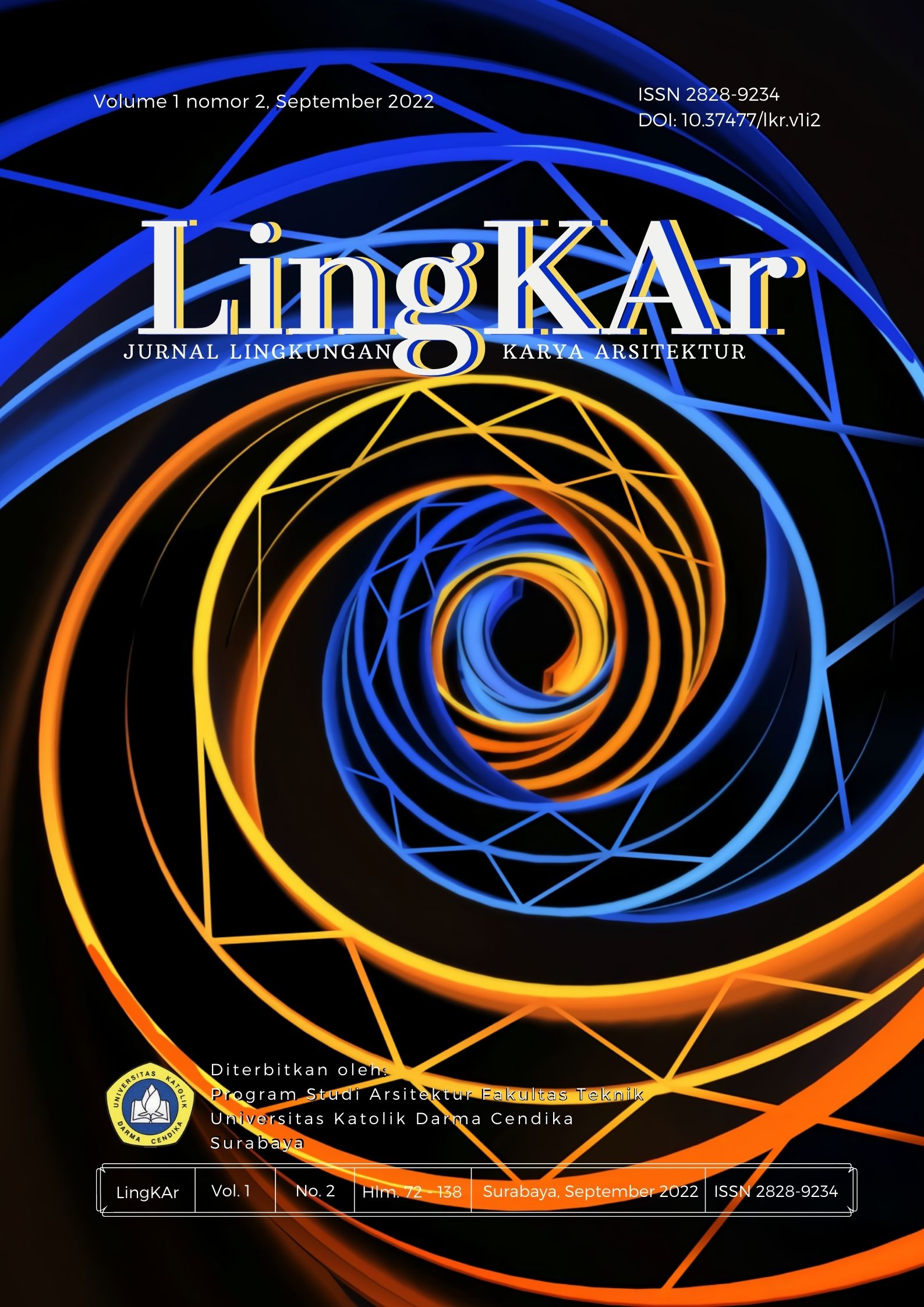Relasi Fungsi, Bentuk dan Material Pada Arsitektur Rumah Baja Karya Ahmad Djuhara
DOI:
https://doi.org/10.37477/lkr.v1i2.329Keywords:
Ahmad Djuhara, Material, Rumah baja, Relasi FungsiAbstract
Steel house by Ir. This Ahmad Djuhara I.A.I, comes with a prominent metal material dominance. In addition to being used in the main structure and the main outer enclosure, all these materials are displayed in a straightforward and naked manner. Making the expression of this building really unusual. Perhaps because of this, as far as is known, since 2002 it has received the most and widest coverage from the media (print, television and online) than any other architect's works. This steel house received an award from the Indonesian Architects Association (IAI Award), such as confirming the existence and presence of this unique steel house. This study aims to examine how the relationship aspects of Form, Function & Material. The method used is qualitative - descriptive. Through the study of the anatomy of the building, then data collection by means of field observations, direct interviews with users. Then, to fulfill its objectivity, interviews were also conducted on 15 residents (chosen randomly) who live around the location (radius not more than 600 m). The results of the study show that the relationship from triangulation aspects of Form, Function and Material does not work as expected, especially regarding materials. This research is expected to be useful for architectural science, practitioners and students. So that in its design, it is necessary to be more careful in determining the dominance of the material.
References
Evensen, T.Thomas. Archetype in Architecture. Norwegian University, Press, New York, 1987.
Fitria, Tika Ainunnisa. 2018. ‘Pengaruh Seting Ruang Terhadap Perilaku Pengguna Dengan Pendekatan Behavioral Mapping’. Jurnal Arsitektur Dan Perencanaan (JUARA). https://doi.org/10.31101/juara.v1i2.775.
Frick, Heinz dan Mulyani, Tri Hesti. 2006. Arsitektur Ekologis. Seri eko-arsitektur 2. Yogyakarta: Kanisius.
Hanifati, Khusnul; Harjoko, Triatno Yudao. Arsitektur Sebagai ‘Fenomena Kehadiran Manusia’.
SIAR Seminar Ilmiah Arsitektur. ISSN: 2721-8686. 2020.
Heidegger,M.1971. Building Dwelling Thinking. From Poetry, Language, Thought. translated by Albert Hofstadter. New York : Harper Colophon Books.
Jenks, C and Kroft, K. 2006. Theories and Manifestoes of Conteporary Architecture, Ed.2. Wiley- Academy. Chicester.
Lake, Reginaldo Christophori. 2014. ‘Konsep Ruang Dalam Dan Ruang Luar Arsitektur Tradisional Suku Atoni Di Kampung Tamkesi Di Pulau Timor’. E-Journal Graduate Unpar 1 (2): 61–74. http://journal.unpar.ac.id/index.php/unpargra duate/article/view/842/829
Laksito, Boedhi. 2014. Metode Perencanaan & Perancangan Arsitektur. Jakarta Timur : Griya Kreasi (Penebar Swadaya Group), Cibubur.
Lestari, Titi, 2008. Kenyamanan Ruang Alam pada Rumah Baja, Karya Ahmad Djuhara. Tesis S2, UGM.
Mies, V. Pierre. 1990. Element of Architecture, from Form to Place. Nostrand Reinhold. London. Murdiyanto, eko. 2020. Metode Penelitian Kualitatif. LP2M, Universitas Pembangunan Nasional
Veterean, 2020
Norberg-Chulz, C. 1973. Intention of Architecture. Cmbridge : MIT Press.
Pallasmaa, J. & Robinson, S. (. (2015). Mind in Architecture: Neuroscience, Embodiment, and the Future of Design. MIT Press.
Panjaitan, Sri Wahyuni. 2021 /Jurnal Ekspresi Seni – Vol 23 NO. 1. 2021
Permana, A. Y., Wijaya, K., Nurrahman, H., & Permana, A. F. S. 2020. Pengembangan Desain Micro House Dalam Menunjang Program Net Zero Energy Buildings (Nze-Bs). Jurnal Arsitektur Arcade, 4(1)
Saraswati, Oka Ayu., Prijotomo. ‘Penelitian Arsitektur Dengan Metode Penikmatan Arsitektur’.
Seminar Nasional, Universitas Udayana, 2010.
Schulz, C. Norbecg. 1973. Intention in Architecture. The MIT Press
Schulz, C. Norbecg. 1988. Architrcture: Meaning and Place. New York, Rizzoli
Simbolon, H. & Irma Novrianty Nasution. 2017. Desain Rumah Tinggal Yang Ramah Lingkungan Untuk Iklim Tropis. Jurnal Education Building 3(1)
Salura, Purnama. 2010, Arsitektur yang membodohkan. CSS Publishing.
Salura, Purnama. 2018. The Philosophy of Architectural Ordering Principles. International Journal of Engineering and Technology(UAE) 7 (2.9): 52–55.
Downloads
Published
Issue
Section
License
Copyright (c) 2025 Danang Harito Wibowo

This work is licensed under a Creative Commons Attribution-NonCommercial-ShareAlike 4.0 International License.
With the receipt of the article by the journal LingKAr and the decision to be published, then the copyright regarding the article will be diverted to Journal of Journal LingKAr. Darma Cendika Catholic University as the publisher of Journal of journal LingKAr hold the copyright regarding all the published articles in this journal.





